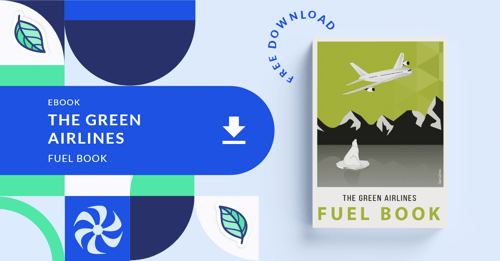22 ways to save fuel during a flight.
Flight Operations have a major influence on a fuel preservation program, as it is during flight execution that significant fuel savings can be achieved. In this article, we embark on a journey to explore several fuel-saving actions to help airlines set up Green Standard Operating Procedures and pilots improve the fuel efficiency of their flights. These eco-flying techniques not only contribute to reduced operating costs but also play a crucial role in reducing the environmental impact of air travel.
In this flight ops fuel efficiency recap, you will find the main techniques to optimize fuel burn during all phases of flight. It's important to note that implementing these fuel efficiency techniques depends on many factors, and the ultimate decision on whether they can be safely applied lies with the pilots.
|
Summary |

Fuel economy initiatives during the briefing or at the gate
1. Pilot Extra Fuel Optimization
Pilots will and should remain responsible for deciding how much fuel they put in their aircraft and may add Discretionary Fuel, also known as Pilot Extra Fuel, which comes on top of all other reserves (contingency fuel, holding fuel, alternate fuel…). The information available at the briefing stage is a crucial element in the decision-making process for carrying discretionary fuel.
More about it >>> Reducing pilot extra fuel without compromising safety
|
💡Pro Tip To help them in the decision-making process, it is a good practice to share statistics about flight plan accuracy and pilot extra fuel usage (with percentiles). This helps pilots decide the best amount to take based on other pilots’ experience on the same route and in similar conditions. |
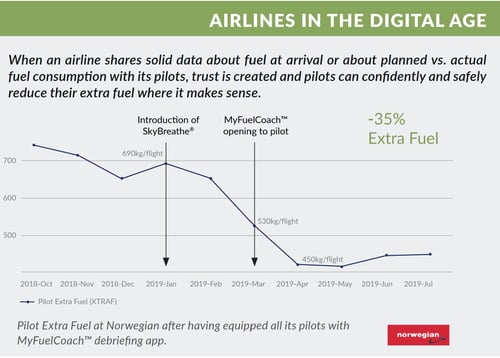
2. Engine-Out Block Off
Start-up and ramp departure procedures should be efficient. By implementing the Engine-Out Block-Off, you can prevent starting the engine while the aircraft is still parked at the gate. Consider delaying push-back, engine start, and taxiing when suitable and possible. Try to absorb an ATC delay at the gate with the engines off.
Eco-flying techniques during taxi-out
3. Engine-Out Taxi-Out
Shutting down one engine during taxi is a safe and widespread best practice to save fuel. Although not as popular as Engine-Out Taxi-In (EOTI), Engine-Out Taxi-Out (EOTO) is practiced by many airlines on a wide range of aircraft, especially during long taxi times.
Engine-Out Taxiing requires more anticipation compared to taxiing with all engines operating.
ℹ️In just 5 minutes of single-engine taxi, a B777 will save 65kg of fuel.
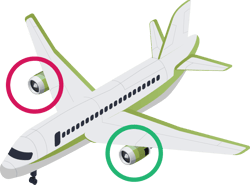
|
💡Safety tip Ensure that this procedure is documented in Company SOPs, including limitations and required conditions, and that flight crews are trained. |
4. APU During Taxi
Once engines are running, consider shutting down the Auxiliary Power Unit (APU).
More about it >>> How to track your APU fuel burn on the ground
Fuel-saving actions at take-off
5. Rolling Take-Off
A Rolling Take-Off is where an aircraft begins its take-off roll on the runway without coming to a complete stop before applying full power to the engines. In a traditional take-off, the aircraft starts from a standstill, increases engine power, and accelerates to gain enough speed for a safe lift-off. In contrast, during a Rolling Take-Off, the aircraft smoothly transitions from taxiing to the take-off roll without stopping.
Rolling Take-Offs are often used to optimize efficiency. By reducing the time an aircraft spends on the ground and in the take-off roll, airlines can minimize fuel consumption and increase overall operational efficiency.
6. Reduced Flap Take-Off
A Reduced Flap Take-Off will improve fuel consumption by reducing drag. For example, on a Boeing 737-800 with winglets, Boeing indicates that a flap 5 take-off can save 10kg of fuel compared to a flap 15 take-off.
More about it >>> Reduced flap take-off - Explained (Video)
|
💡Safety tip In all cases, the flap settings must be chosen to ensure aircraft safety according to the required performance at departure. |
7. Reduced Thrust Take-Off
In Reduced-Thrust Take-Off and climb (also called derated take-off or flex take-off), the aircraft's engines are operated at less than maximum thrust, reducing the power output compared to what would typically be used for take-off. This will increase fuel burn; however, engine life is preserved, and specific fuel consumption over the engine's life is reduced.
Most engine wear will occur at the highest temperatures and a 1% reduction from full take-off thrust will result in some 10% savings in engine life, as the last few degrees are the most damaging. Consistent use of reduced thrust will more than double engine life, especially when the engines are cold.
More about it >>> Why should pilots apply reduced thrust takeoff
 |
Get your infographic showcasing all the fuel efficiency best practices per phase of flight! |
8. Pack-Off Take-Off
During Pack-Off Take-Off, one of the aircraft's air conditioning packs is temporarily turned off to reduce engine workload and save fuel during the take-off phase. This practice helps optimize fuel efficiency without compromising passenger comfort significantly.
Optimizing fuel consumption during the climb phase
9. Reduced Acceleration Altitude
Once airborne, flaps and slats should be retracted as soon as possible within safety limits. This best practice is called Reduced Acceleration Altitude. Some airlines have reduced flap retraction altitudes to 1000 feet AGL or even lower depending on the aircraft type (ICAO calls this NADP2). Reduced flap retraction altitude is even more important when higher flap settings are used for take-off.
More about it >>> Why lowering aircraft acceleration altitude improves fuel efficiency?
Boeing claims that the fuel saved by flying an NADP2 procedure vs an NADP1 procedure is 67 kg on a Boeing 737-800 with winglets and 197 kg on a Boeing 777-200ER.
|
💡Pro Tip When applying reduced acceleration altitude, pay attention to the noise abatement procedures applicable at the airport. Many large airports, especially in Europe, prevent accelerating before 3,000 feet (ICAO calls this NADP1). |
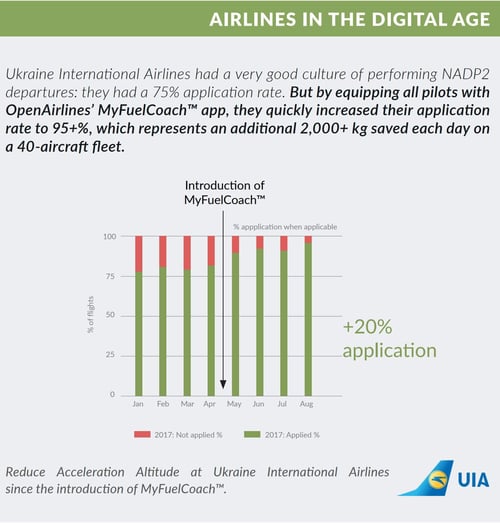
10. Continuous Climb Operations
Aircraft applying Continuous Climb Operations (or CCO) employ optimum climb engine thrust and climb speeds until reaching their cruising levels. This results in time being spent at more fuel-efficient, higher cruising levels, hence significantly reducing fuel burn and lowering emissions and fuel costs.
In-flight fuel optimization during cruise
11. Re-Planning
Re-Planning is a crucial practice to keep in mind when flying. There might be new information during an ongoing flight concerning flight conditions that can lead to a new and more optimized flight plan. The easy access to precise information for the crew is critical in this case.
12. Directs
In the moment of re-optimizing the flight plan and when ATC allows it, requesting Direct inflight is a great way to save fuel and improve on-time performance. By properly analyzing past flights, airlines can share information with their pilots on the most granted and useful Directs.
Related content >>> Flying shorter with directs
13. Optimal Flight level
Systematically flying at the Optimum Flight Level will save fuel. As an aircraft burns fuel, it becomes lighter and can reach higher altitudes, where it is usually more efficient. The Optimum Flight Level depends on the aircraft's weight and aircraft's performance but also on winds and temperature deviations that can differ with altitude.
14. Cost-Index
In normal cruise conditions, FMS-equipped aircraft should operate using the agreed Cost-Index. The actual Mach speed will result from aircraft weight, altitude, temperature, and wind conditions. The Cost-Index should not be changed to control the Mach number. As winds, weights, and flight levels change, allow the FMS to compute the Mach number and stick to it.
Related content >>> Top 10 facts or myths about Cost Index
Without FMS speed optimization capabilities, a fixed Mach speed like Long-Range Cruise (LRC) is typically used. These speeds do not vary with wind components and are thus less efficient. Modern flight planning systems can compute a Cost-Index-optimized speed for non-FMS airplanes. These speeds can then be displayed on the flight plan and used by the flight crew.
Reducing fuel burn during the descent & final approach
15. Continuous Descent Approach
Whenever possible, plan to fly a Continuous Descent Approach (CDA) or Continuous Descent Operations (ICAO name). With accurate descent winds loaded, the FMS computes a largely accurate, efficient descent profile and an optimum Top of Descent (TOD). Do not descend early or late or modify speed and descent rates unless told or required to do so, and update the FMS in such cases. Starting a descent profile too early or too late will generate significant extra fuel burn.
Use the most efficient speeds, continuously trading speed for altitude or vice versa as required unless specific speeds are assigned. Avoid the use of speed brakes as much as possible. Energy management should always be kept in mind.

Even when no CDA procedure is published, it is often possible to perform CDAs at most airports. Sharing statistics on CDA application can help pilots request them when they are most likely to be granted.
16. Short Approach
Where allowed (airport/ATC regulations, company SOPs, current conditions) and if the airport is not too congested, a Visual Approach or a Short Approach may be considered instead of sticking with the announced standard arrival procedure (STAR).
17. Precision Approaches and Low-Noise Low-Drag
Some airlines have developed Precision Approaches (also known as PBN or RNP-AR), where the aircraft, the airlines, and its pilots are certified to follow a GPS-designed procedure.
They can increase safety and reduce fuel consumption by specifically optimizing the approach profile. Within safety limits of current conditions and keeping in mind company SOPs for stabilization criteria, avoid deploying flaps and landing gear too early to avoid wasting energy; this Best Practice ties in with the general concept of Low-Noise, Low-Drag approaches.
Fuel efficiency procedures for landing
18. Reduced Flap Landing
Reduced Flap Landing will reduce fuel burn and decrease noise and emissions where it counts- around the airport.
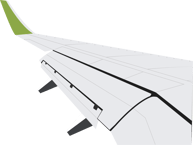
Operational conditions apply, of course, and will be part of the SOPs. Reduced-Flap Landing will see an average 5 knots higher touch-down speed and an extra landing distance of around 500 feet (for A320/B737). Several airlines have made reduced flap landing procedures standard except for high-altitude airports, contaminated runways, or airports with short runways.
19. Idle Reverse Thrust
Use Idle Reverse Thrust after touchdown. Again, operational conditions apply and will be part of the SOPs. Advantages include extending engine life thanks to:
- one less high-power cycle,
- less foreign object damage (FOD),
- slower engine performance deterioration,
- increased reliability
Other benefits include lower fuel burn and noise, passenger comfort, and operationally, a lower cooling time requirement before shutting (an) engine(s) down for Engine-Out Taxi-In.
Related content >>> Idle Reverse Thrust explained (Video)
Reducing aircraft fuel use during taxi-in
20. Engine-Out Taxi-In
When conditions allow, many airlines use the Engine-Out Taxi-In (EOTI) procedure as standard. Well-designed SOPs are required, as well as flight crew training. Runway crossing, taxiway/ramp surface condition and gradient, last turn angle, and aircraft constraints (as regards to which engine can be shut down) are factors, among others, to be considered when applying Engine-Out Taxi-In.
Anticipation is key in keeping the aircraft moving. The main advantages are lower fuel burn and noise and, especially with twin-engine aircraft, lower brake wear.
Related content >>> What you need to know about Engine-Out Taxi-In
21. APU During Taxi-In
Unless you perform an Engine-Out Taxi-In and the manufacturer’s procedure mandates to switch the APU on, start the Auxiliary Power Unit as late as possible when you arrive at the gate (APU during Taxi-In).
Sharing fuel-saving insights during debriefing
22. Eco-Debriefing
Observations show that flight crew fuel ‘efficiency’ on short to medium-range operations can vary by 2-3 %, depending on the level of awareness/engagement, background, and training.
Training and awareness are key, of course, as well as management leadership and accountability.
When the crew is empowered with the right tools that help them have a better understanding of which fuel-saving best practices they can apply, on which routes or airports, and what the stakes are, we witness very good progress in application rate.
WANT TO LEARN MORE?
Discover more airline fuel-saving tips & best practices in The Green Airlines Fuel Book >> Download the Ebook.




